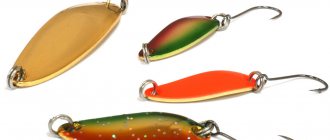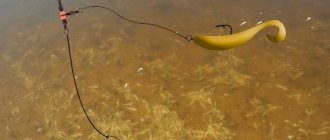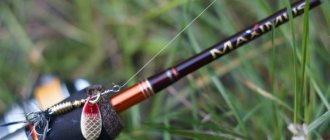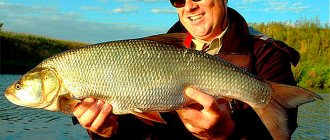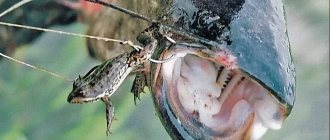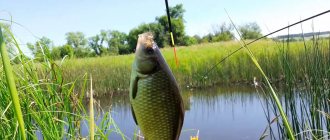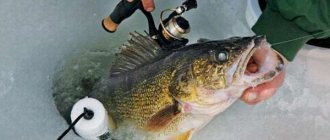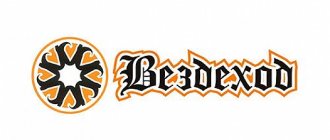Relatively recently, a type of fishing called jigging has appeared. This kind of fishing involves using sinkers of a wide variety of shapes at the end of the cord along with various silicone baits. The product did not have to wait long for its peak popularity. Many people immediately fell in love with this type of fishing, and now even professionals fish with jigs at various competitions.
On the one hand, it seems that there are no particularly complex things here, but you also need to be able to understand them and understand the nuances.
What is a jig
Essentially, there are two large groups into which equipment can be divided:
- Jig heads. Here the hook and sinker form a single unit.
- Offset installation. Implies a division into a load and a hook. This increases the number of combinations that we can make from different weights and hooks. The use of such a movable connection ensures a more natural play of the bait in the water, and due to this, we increase the chances of getting the long-awaited bite.
Jig heads
In this combination, the hook and sinker are integral. And due to this, we can say that strength increases in a certain sense. In addition, it is much more difficult for a trophy to come off such a rig, whereas in offset mounting it is possible to straighten the attachment of the hook to the main line through the sinker.
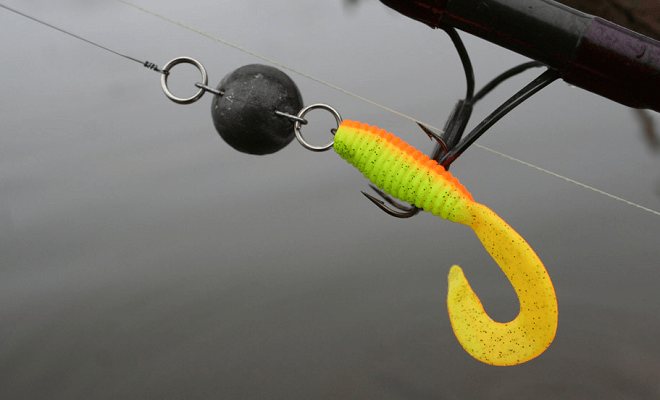
Jig offset installation
Jig heads can be divided into several categories based on weight. Nanojig heads weigh up to approximately 4-5 grams. Microjig reaches a weight of 10-11 grams. A light jig ranges around 11-22 grams, and anything that exceeds this weight will already be called a heavy jig or heavy . In general, there are many different classifications of weights, but the most important thing is that the fisherman understands what weight he needs for a given situation.
Material
The choice of material from which jig heads and Cheburashkas are made is quite meager. There are only three types. Lead is the most popular. It is quite cheap and has a low melting point, which allows you to easily cast weights at home. By the way, more and more avid fishermen are starting to cast sinkers at home to get exactly the result they want. With powerful pike or zander bites, memorable marks from the teeth of the predator remain on the lead weights.
Tungsten weights are not so popular because of their high cost, but wealthy and demanding fishermen use them, since such parts have much more mass than lead ones with the same volume. Due to this, you can make even longer casts and punch the deepest holes in search of a trophy.
Few people know, but there are also floating jig heads. They practically do not sink and are perfect for fishing in places where the bottom is covered with vegetation, and the action of the bait will not be what it should be.
Varieties
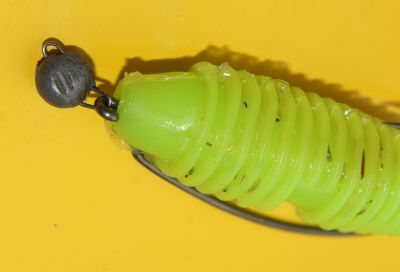
At the very beginning of mastering the topic of jigs in shallow water, I used jig heads. I just came across them one day in 1999 (they turned out to be Gamakatsu brands) in some store at pre-default prices. And I bought them all... Those heads were of the “correct” weight - 2 - 2.5 g, but what raised doubts was the size of the hook: mostly No. 1, on some - No. 1/0. Considering that now, under the same conditions, I use hooks more often than number 4/0, then the sizes of the hooks on those jig heads could be called “childish”. This is how it actually turned out: there were no questions with the “laces”, but pike from “under a kilo” and above more than once unbent small hooks...
The identified problem remains relevant today: it is not so easy to find a jig head of extremely light weight with a large, powerful hook. Therefore, we do not particularly consider installation with a jig head in our current context.
What then? There are four options. The first one, which seems to suggest itself, is with a collapsible Cheburashka. But here there are very high chances of “running into an ambush”, which was mentioned at the very beginning: these are “ears” made of thin wire, which break out even under a very moderate load. And the fish leaves with a hook in its mouth... Therefore, the first collapsible weights that come across, weighing one and a half to two grams, are unlikely to suit us. Perhaps the second and third... But it’s still possible to find reliable ones. Not all of these “foundry workers” rely only on a finger-sized perch.

To be on the safe side, I often do this. I mount an offset hook on a collapsible “eared” hook, and then clamp the lead heads with pliers. It is clear that the structure becomes non-demountable. But it is important for us that it acquires additional tensile strength.
We have already begun to wean ourselves from non-separable weights (with soldered “ears”), but in this case they are, perhaps, preferable. It is clear that it is precisely because it is stronger. But such a weight requires a winding ring. It also won’t suit everything. The ring should not be thick so as not to wedge in the “ear” of the weight and in the eye of the hook, plus, again, it should be strong enough. The ring option is number two.
What forms are there?
There are a large number of forms:
- boot;
- ball;
- banana;
- bullet;
- ski;
- rugby;
- spoon and so on.
The most popular shape is the ball. Such products are used in almost any situation. When choosing the shape of the load, you need to select a shape that will be subject to the least drag, otherwise the fisherman will wait a very long time for the load to touch the bottom.
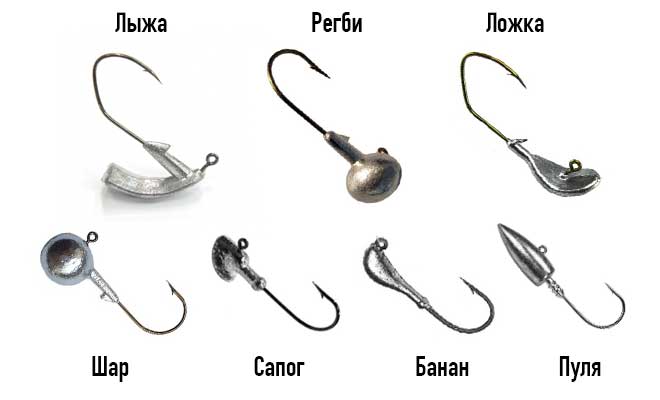
By the way, there are so-called planning forms of sinkers. It must be said that they almost immediately come off the bottom. They should be used on an overgrown bottom or where frequent snags are possible. Due to their instant detachment after the start of wiring, they will not cling as often as conventionally shaped loads.
Important! It should be noted that when fishing in snags, one of the best forms is the ball, because it has much less chance of getting caught between the branches.
There are also non-meshing installations, in which the hook is protected in some way. Typically, the hook is protected with a thin wire extending from the sinker and resting on the hook. Of course, such non-clinging ones will cling much less to various debris on the bottom, of which there is quite a lot near large cities. But you should remember that when using a closed hook, the number of bites will noticeably decrease, since the fish needs to push through this wire and sit on the hook.
The last choice here is up to the fishermen: either use an open hook and take a little risk, or use a non-hooking one and lose a certain percentage of bites.
Spinning rod for jig fishing
It is fished with a jig head using a spinning rod. The gear must meet the following requirements:
- Reliability.
- Strength.
- Sensitivity to bites or, as they say, to be “ringing.”
- Small sizes. The optimal length is from 2.5 to 3.0 meters.
- Jig head weight (test range from 5 to 40 grams).
- Build. There are slow, medium and fast.
- Aggressive wiring.
- Fishing depth.
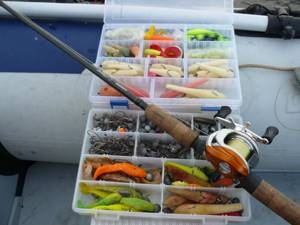
The test indicates what weight the jig head should be. This indicator is indicated on the spinning rod in grams (g). Another indicator that you need to pay attention to is the build. It shows the rigidity of the rod and the speed of straightening of the spinning rod after casting, and affects the casting technique. So, with a fast action rod there is a sharp and short swing, and with a slow action rod there is a wide swing from behind the back.
There are special spinning rods for jig fishing on sale. It is advisable to use it for catching pike perch, as its bite is gentle. Sometimes it can only be seen by the vibration of the rod tip. But for catching pike and perch, a regular spinning rod is also suitable, because their bite is sharp and aggressive.
If you want to find out what gear pike perch bites best with, you can read our article.
Three types of reels are used for spinning:
- Inertial.
- Inertialess.
- Animators.
Inertia-free ones are more popular, since with their help, casting occurs farther than with inertial ones, the line is reeled off exactly as far as the jig head has flown, and the line does not get tangled. After the bait falls to the bottom, inertial reels continue to unwind the fishing line, which often results in it getting tangled. The only drawback of a spinning reel is its higher price.
Multipliers are powerful reels that are used when catching large fish with heavier bait in lakes and seas. The reel is attached to the spinning rod so that the center of gravity is 5 centimeters higher.
Line for jig fishing
For spinning, you need to choose a thin and strong fishing line. The thinner it is, the further the cast will be. Strength is needed, firstly, so that a break does not occur during casting, and secondly, when landing fish. For beginner fishermen, nylon monofilament is suitable. All its parameters are indicated on the packaging. The thickness of the fishing line and the weight of the fish that this fishing line will support are indicated there. The disadvantages of monofilament include its stretchability, that is, an increase in length under a load of 15 to 20%.
READ Fishing for Devil in Winter Video Technique • ARTAFISH.RU
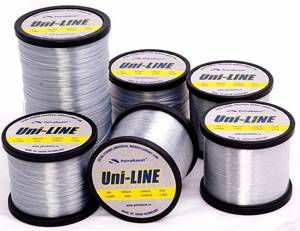
This fact leads to the fact that some bites of large fish are unnoticeable on casts of 50 meters or more. Experienced fishermen purchase more expensive braids and fluorocarbon fishing lines, which have the same light refraction as water and are completely invisible to fish. They are more tensile, do not stretch at all, and transmit the weakest bite to the rod that the hand feels. When fishing for small pike and pike perch up to 5 kilograms, a fishing line from 0.2 to 0.4 mm is suitable.
2. Leashes
When fishing, you need to secure the jig head with the main line using a leash. It should withstand a load one third less than the main line, and protect it only from getting caught on the bottom of the reservoir or on snags. By the way, when fishing for pike and pike perch, you also need a leash between the jig head and the breaking leash. It prevents the fishing line from being cut by the teeth of a predator, and is made of braid, tungsten, and thin steel wire of different lengths.
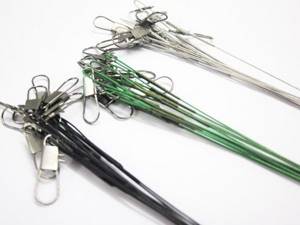
Jig head hooks
There are three types of hooks:
- single;
- double;
- offset.
Single hooks are used mainly for rigid connection with a sinker, when the hook is tightly embedded in the sinker. This type of hook is the most popular due to the fact that you don’t have to mess with it. The fisherman can only attach the necessary jig baits and send them to conquer the underwater expanses. Due to one hook, the number of hooks will not be particularly large.
Double hooks are used in places where the fisherman knows for sure that there are no hooks, otherwise after a couple of casts it will be possible to easily leave the bait on the bottom. Double hooks are commonly used for baiting foam fish. By using this material, snags can be avoided, since the ends of the hooks enter the foam rubber and do not stick out. This form of hook has become very popular when fishing for pike perch.

And finally, the most difficult hooks to maintain are offset or simple offsets. They have their distinctive shape due to the bend near the eye of the hook. With the help of this bend, the bait does not fly off the hook when falling into the water after casting.
Such products can be used both in a closed type, piercing the silicone bait in two places, and in an open type, placing the bait on a regular single hook. Avid professional fishermen use just such hooks for fishing, as they have the highest percentage of effective bites and at the same time you can fish in snags without fear of losing the bait.
Jig tackle with an offset hook has one big drawback: it needs to be assembled. Select the sinker and hook separately. It’s good when the Cheburashka is collapsible, but there are some that are not collapsible, into which you first need to insert winding rings for connection. Therefore, it is necessary to decide in advance on the type of Cheburashka so as not to waste precious time while fishing.
TOP 5 postings
In nature, there are many types of fishing that are used for fishing with jig heads. The fishing portal FishingSib has selected the TOP 5 most popular ones for you.
Stepped.
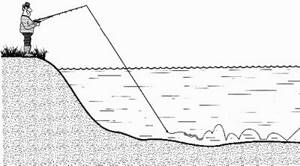
This type of wiring is considered the main one in jig fishing. On the river, the bait can be moved with stepped wiring both with the current and across or against it. When performing stepwise retrieving: after casting, the angler lets the bait sink to the bottom, then makes several (usually 2-3) turns with the reel handle, then pauses, at which time the bait rises and swims a few meters, then sinks to the bottom again. After the bait touches the bottom, the fisherman rewinds the line again.
American.
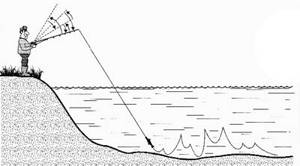
This type of wiring is often used when fishing for pike perch. After the bait falls to the bottom, the angler makes a soft pull with the rod, after which he picks up the slack in the fishing line with the reel. After the bait falls to the bottom again, the next jerk is performed. The usual length of such a pull is 1-2 m. Thus, American wiring is very similar to step fishing, with the only difference being that it is performed with a rod and not a reel.
To be demolished.

This is a unique type of American wiring. The fisherman casts across the current or a little upstream, and after the bait falls to the bottom, he begins to play with it: with a swing of the rod, he lifts the bait above the ground, after which it swims some distance and falls to the bottom again, and the spinner again “throws » her up. In this case, the fishing line is not reeled in at all as long as you can play with the bait without taking out the slack.
Aggressive.
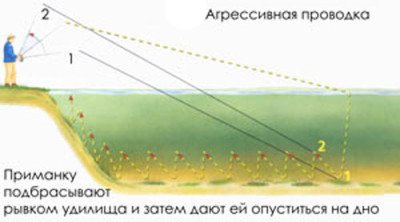
Designed for active fish - pike, perch or pike perch. After falling to the bottom, the bait is thrown up with a sharp swing of the tip of the spinning rod, similar to a hook. Then the angler pauses, lowering the rod to a horizontal position and reeling in the slack line, allowing the bait to fall to the ground again, after which another jerk follows.
Uniform.

The fisherman casts the bait, waits until the bait has dropped to the middle of the depth of the reservoir, and begins retrieving, evenly reeling in the fishing line. If we rotate the reel handle too quickly, our bait will come at us with a rise to the surface. If you rotate it very, very slowly, the bait will gradually bury itself until it falls to the bottom. Well, you can achieve an intermediate option when the bait moves strictly horizontally - this is uniform wiring.
Andrey Pitertsov talks about various jig bait placements
Jig bait
Well, and of course, what is jig fishing without bait? Entering a fishing store, a person will see huge stands with rubber for every taste and color.
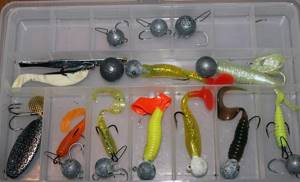
All baits can be divided into 2 broad categories:
- active;
- passive.
Active baits include various twisters and vibrotails. They have more energetic and frequent play. Passive baits include various types of crustaceans, spiders and even lizards.
There is also rubber with a smell. The most popular are: shrimp, anise, squid. Many fishermen are skeptical about scented baits, believing that the smell has no effect on the number of bites and may even, on the contrary, scare away the fish. Other fishermen use odorous rubber for a very passive predator, when the fish need to be provoked to bite using a variety of methods.
Since baits come in completely different colors, here you also need to know some rules by which you should choose rubber when fishing. It should be said that in sunny weather you should not use too bright colors, such as red and orange. They will be too noticeable in the water. In cloudy weather or when fishing in muddy water, these colors will be just to the taste of the fish, since they are visible from quite long distances.
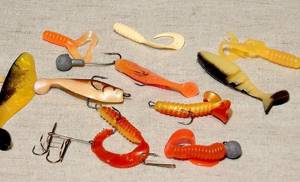
If you have a specific goal in catching a trophy, then you shouldn’t skimp on bait. Professional fishermen set baits of 15-20 centimeters and successfully fish with them. It often happens that a large pike weighing 7-8 kilograms won’t even look at a 5-6 centimeter bait. Here everything is like in the saying “a big piece and the mouth rejoices.”
Rubber can be made from completely different silicones. One may be hard, while the other will be easily crushed by your fingers. The softer the silicone from which the bait is made, the more natural the play in the water will be. But soft material also has its disadvantages. It will not be as durable as a hard one. After each fish bites, the bait will acquire more and more bite marks, and eventually some fish will tear it completely, which means that the fisherman will be forced to change the bait.
But do not forget that harder silicone baits will not play as well in still water as soft ones. Therefore, for each reservoir it is worth selecting the nozzle individually. For strong currents, it is worth installing such hard silicones.
Read more about how to properly attach a vibrating tail to a jig head and other equipment.
Vibrotails and twisters have gained the greatest popularity among fishermen. For many, they are the best jig baits. They have a tail in the form of a small blade or crescent, therefore, due to this, even with the slowest retrieve they will play quite energetically. It is worth placing the bait on the jig as evenly as possible so that the vibrotail in the water looks like a feeding fish.
How to choose jig tackle?
The shape, weight and quality of the sinkers have been decided, but an important issue is the selection of optimal gear with which the fishing hunt will be very successful.
Spinning
Choosing the main attribute for fishing with a jig head is the most important point that needs to be approached with all responsibility. The most important question that the angler must answer for himself is where the fish will be caught with a jig - from the coastal zone or from the water surface (from a boat).
Spinning for the coastal zone
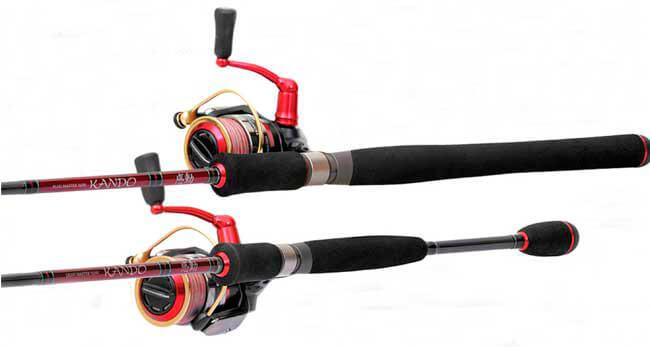
The length of the blank for a coastal spinning rod does not exceed two meters and seventy centimeters (270 cm). The action is fast or medium-fast with the upper limit of the blank test being no higher than twenty grams.
Such a spinning rod will allow you to record any contact of a predatory fish with an abandoned bait and make a reliable hook.
The most popular models of poles for the coastal zone:
- Kando 902MH (]Norstream[/anchor]);
- Craft Rizer 832MH (Major);
- Thunder 90MXF2 (Banax);
- Psychogun 912MMHSF (Pontoon21);
- Ultimatum 962HMF (Daiko).
Spinning rod for fishing from water (from a boat)
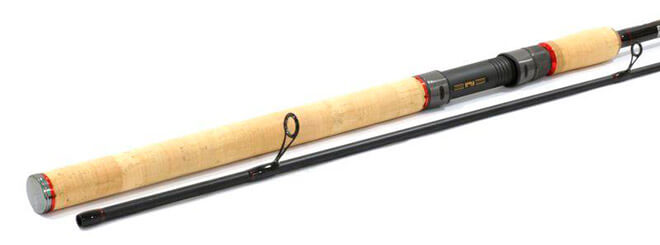
The length of the blank for a boat spinning rod does not exceed two meters and ten centimeters (210 cm). The system is fast or ultra-fast with the upper limit of the blank test being no higher than fifty grams. The power of a boat spinning rod allows you to speed up fishing and prevent the prey from getting off and tangling the tackle.
Options for sticks for fishing from the surface of the water:
- Partner 70H (Norstream);
- Harrier 702MHF (GAD company).
There is another classification of sticks for jig fishing - universals, which are optimal for both one and another type of fishing. Most often, it is in this category that beginner “jigers” choose forms.
The length of the universal stick blank is from 2.20 to 2.40 meters with a fast action and an upper test limit of up to forty grams.
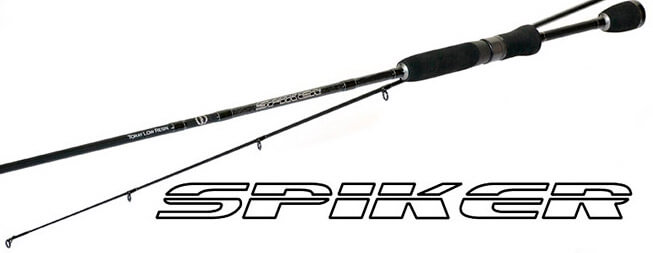
When choosing a station wagon, you should take a closer look at the following spinning rods:
- Spiker 782MH (manufactured by Norstream);
- TinFish 80MF2 (manufactured by Banax).
Coil

With all the diversity in the model range of reels, the usual budget version of a spinning reel seat is suitable for spinning for jig fishing.
The only thing you should pay attention to is the weight of the bait:
- up to fourteen grams, the size of the coil varies from seven hundred fifty to two thousand;
- from fifteen to thirty-five grams - a coil from two to three thousand.
fishing line

The fishing line can be monofilament or braided, but in any case, the choice of this device will depend on the type of intended production. If a fisherman has a strong interest only in perch, then in this case the best option would be to choose a monofilament fishing line.
Any of the selected modifications of the fishing line must be wound onto the spool at a level with the side.
Correct selection on the pond
In order to avoid getting into trouble while fishing, you need to be able to correctly select the weight of the load, hook and bait for specific conditions.
First of all, when you come to a pond, you need to find out the depth at which fishing will take place. This can be done using an echo sounder, or simply start punching the bottom with a load and draw conclusions based on the time of fall. Sometimes the holes are so large and with a strong current that jig heads weighing 40 grams have difficulty breaking through the bottom. On reservoirs with stagnant water, the weight of baits, as a rule, will not exceed 20-25 grams. This will be quite enough.
Having decided on the depth, you need to understand whether there are any hooks at the bottom. This can be done either using the same echo sounder, or by tearing off a couple of baits. Based on these readings, you need to select the right hook and sinker shape.
Well, and most importantly, you should set a bait. With experience, everyone will determine for themselves the best lures and jig tackle that will be used on almost every fishing trip. If you experiment with color and size, you can walk away with a good catch.
Jig fishing methods
There are many ways to catch fish with a jig head:
- Search.
- Step-uniform step.
- Stepped heavy.
- Stepped easy.
- Stepped long.
- Stepped short.
When fishing in an unfamiliar body of water, they always start with a “search” method, which will allow you to study the bottom and possible habitats of the fish. To do this, take a heavier jig head. The casts are made randomly and as far as possible, after which the wiring is done. After examining the bottom and a few bites, we proceed to traditional spot fishing.
To do this, attach the necessary jig head and choose a different fishing method. If there was not a single bite during the “search” method, we move to another place in the reservoir until we determine the accumulation of fish.
READ Carp reels
Stepped-uniform wiring is good when passive predators lie on the bottom of the reservoir:
- The cast is made.
- When the jig head has reached the bottom, we begin to slowly wind the line with the reel at a speed of one revolution per 2 seconds. Make 3-4 turns.
- Let's stop for one second.
- We continue the action with the coil.
- With this method, the jig head with a nozzle seems to hover above the very bottom, flies in front of the fish’s nose, and sometimes crashes into it, provoking an attack.
The most common wiring for jig fishing is stepped. It has several varieties:
- Heavy.
- Easy.
- Long.
- Short.
The meaning of the work is the same for everyone, but with different parameters:
- A jig head with a nozzle is cast.
- The spinning rod is held at 45 degrees relative to the water.
- When the weight reaches the bottom, the line loosens and the rod tip straightens. At this moment, the sinker raises a cloud of silt.
- It is necessary to remove the slack in the fishing line by rotating the reel handle. Usually this is 2-4 turns.
- We make several sharp rotations with the reel handle. If you make 3-4 turns, you get a long step, and if you make 1-2 turns, you get a short one. At this moment, the jig head comes off the bottom and flies through the water column for several meters: in the first case 1-2, in the second 0.5-1.
- The rotation of the reel handle stops, and the head falls to the bottom again.
- After 1-2 seconds, sharp rotations are repeated.
And so on until the jig head approaches the fisherman, or a fish grabs it. Some fishermen replace sharp rotation of the reel handle with twitching the rod, or with a joint movement. Each fisherman adapts individually. The result is a jumping or stepping motion.
At the moment of the bite, it is necessary to make a sharp upward movement with the rod from 45 degrees to 90, which will lead to hooking the fish, and reel it in.
With a heavy retrieve, the weight of the jig head is a little heavier and it almost slides along the bottom. With a light head, the weight is less and it bounces high, as if swimming in the water, making wave-like movements.

